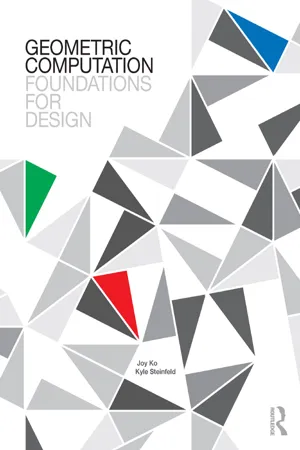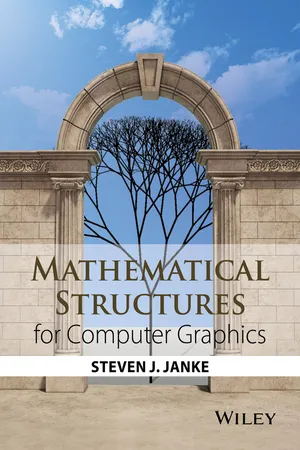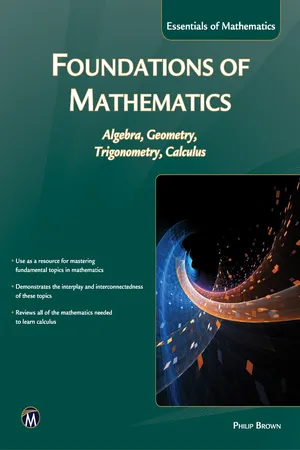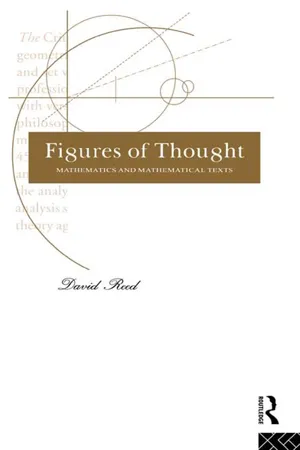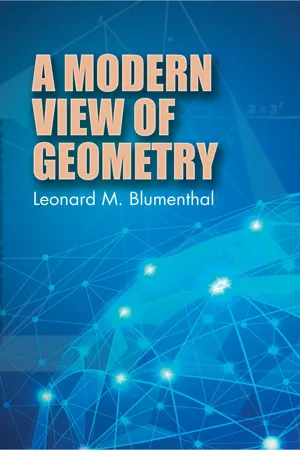Mathematics
Points Lines and Planes
Points, lines, and planes are fundamental geometric concepts. A point is a location in space with no size, a line is a straight path that extends infinitely in both directions, and a plane is a flat surface that extends infinitely in all directions. These concepts form the basis of geometry and are used to define and describe shapes and figures.
Written by Perlego with AI-assistance
Related key terms
7 Key excerpts on "Points Lines and Planes"
- eBook - ePub
- Joy Ko, Kyle Steinfeld(Authors)
- 2018(Publication Date)
- Routledge(Publisher)
1.06 LINES AND PLANESThis chapter weaves together a number of related stories of common formulation, both mathematical and in code, that unfold at a moment that our primary focus returns again to geometry, and to two entities which are staples in any computational geometry library: lines and planes. Beyond the central role these two objects play in the definition of form, a discussion of their implementation in code will bring to the foreground a more nuanced set of issues surrounding data representation than we have attempted thus far.Our first story might appear to be one of competing rather than common formulation, as both of the protagonists of this chapter seem to be equally well-described through a variety of means. As we saw in the Structured Data Types section of Chapter 1.02 , lines may be described equally well in code either by two points, or by a point and a direction. Likewise, planes can be determined either by three encompassed points, by a single point and a special direction called the plane normal, or by the coefficients of a general equation. Given our understanding of object-oriented design thus far, we have regarded competing implementation options such as these to be mutually exclusive, and deterministic of which attributes of an object are truly fundamental members and those which are derivative and only accessible by way of methods or properties. In this chapter, expanding upon a technique presented in a section on the length property of Vecs in Chapter 1.03 , we will see that this mutual exclusivity is only partially required, and that through the careful coordination of members, properties, and property-setters, we can design classes that practically manifest multiple representations simultaneously.Our presentation begins with lines, familiar entities that we have already put to active use in a number of examples. Our first step in formally introducing the geometry of lines develops a mathematical account that moves away from familiar scalar equations, and instead adopts a vector representation. This approach not only couples well with the nature of the geometries presented earlier in this text, but is also based on a robust mathematical foundation that holds true regardless of the dimension of the space in which the line resides. Building on this foundation, we describe the implementation of lines in code, and again find advantage in a common formulation. In a number of examples we have already put to use two distinct line-like geometric entities from the Decod.es library: the Segment, which we introduced as a line of finite length, and the Ray, which was given as a one-sided line. Although distinct, these two types share sufficient features in common such that they may be related via the traits of a common ancestor. As such, we will demonstrate the implementation of a more abstract class called LinearEntity, and will take the opportunity to give a more thorough treatment of the powerful feature of OOP known as inheritance - eBook - ePub
- Steven J. Janke(Author)
- 2014(Publication Date)
- Wiley(Publisher)
Chapter 3 Vector GeometryMuch, if not most, of the graphics pipeline relies on asking geometric questions about objects in a scene. At the modeling stage, it is helpful to know where the middle of a face is or whether four vertices lie in a plane. If we think of light as traveling in rays, then asking where a ray intersects an object is key to understanding the shade of the object and the shadow it casts. The task now is to take the notion of a vector and use it as efficiently as possible to make geometric calculations. The goal is threefold: express the calculations simply so that producing an algorithm is relatively easy, make the calculations general so that the algorithms are easily extended, and keep an eye on the number of elementary arithmetic operations in each larger calculation so that the resulting computer code runs quickly.Vectors fit Euclidean geometry particularly well, which means that linear structures such as lines and planes along with circular structures (with fixed radii) are the focus of attention. We certainly want to eventually extend our reach to more organic shapes, so we look for ways that vector calculations change our perspective in describing nonlinear forms.3.1 Lines and Planes
3.1.1 Vector Description of Lines
One way to describe a line is to say it contains two particular points, say and . This allows us to construct the line (actually draw it on a piece of paper), but it does not say much about the other points on the line. Analytic geometry takes the Cartesian coordinates of the points and produces a more complete description. Assuming the line is two dimensional and the coordinates are and , then the point-slope form of the line yieldsThis description gives the coordinates for all the points on the line and hence is more useful when having to plot pixels on the display screen. A version of the line equation, , gives what we call an implicit - eBook - ePub
Foundations of Mathematics
Algebra, Geometry, Trigonometry and Calculus
- Philip Brown(Author)
- 2016(Publication Date)
- Mercury Learning and Information(Publisher)
2THE CARTESIAN PLANE
2.1INTRODUCTION
In the seventeenth century, the Philosopher and Mathematician René Descartes had the brain wave of joining two (infinite) number lines at right angles so that they intersected at their respective zero points, as shown in figure 2.1 . This creates a rectangular coordinate system that, nowadays, is called the Cartesian plane. The horizontal number line is usually labeled the x-axis, and the vertical number line is usually labeled the y-axis. Each axis has an increasing direction indicated by means of an arrow. The point where the axes intersect is called the origin and labeled O. Descartes and mathematicians following him, including Isaac Newton, discovered a rich interplay of algebra and geometry in the Cartesian plane, one outgrowth of which was the discovery of calculus.FIGURE 2.1. The Cartesian plane.After a brief explanation of how a rectangular coordinate system works (section 2.2 ), we will make a complete study of the relationship between graphs of lines in the Cartesian plane and linear equations in section 2.3 . This is followed by an introduction to circles (section 2.4 ) and conic sections (section 2.5 ) in the Cartesian plane. Vectors are a useful tool for doing geometric analysis in the Cartesian plane, and this topic takes up the remainder of the chapter (section 2.6 ).The mathematical methods in a two-dimensional coordinate system that we introduce in this chapter can be generalized to a three-dimensional coordinate system (although we will not do it in this book). A three-dimensional coordinate system can be used as a mathematical representation of the three-dimensional physical space in which we humans move around; and it is in this coordinate representation of three-dimensional space that mathematicians and scientists can carry out advanced mathematical simulations of dynamic processes like ocean currents, planetary weather patterns, motions of projectiles, and exploding stars. - eBook - ePub
Figures of Thought
Mathematics and Mathematical Texts
- David Reed(Author)
- 2003(Publication Date)
- Routledge(Publisher)
As has been shown, points, lines and straight lines can be completely and satisfactorily related to one another through the definitions themselves. Because of this they do not pose by themselves interesting mathematical problems for Euclid and do not constitute the subject matter of the Elements. None of this can be said for surfaces. 1.3 Surfaces Definition 5 of surfaces mimics Definition 2 of lines with two parts, length and width, instead of length alone. The remarks above on the definition of line carry over with no substantial modifications. Clearly, once again, spatial intuition is not at issue. Nor should it be thought that a specific combination of length and breadth in a notion of area is referred to. The two measurables, length and breadth, exist independently and, at least at this stage of the argument, there is no way to put them together. Definition 6 mimics Definition 3 in specifying lines as the extremities of surfaces as points are of lines. However, the grammar of the plural ‘lines’ differs from that of points. As noted above, it was precisely in functioning as the extremities of lines that any distinctions between points could be drawn. From their definition alone there are no characteristics which would permit either numerical or generic distinctions among them. But lines do have a variety of ways in which the singular/plural distinction can be applied: • lines can differ by length, • some lines can be distinguished as straight lines, • lines can act as the extremities of surfaces (allowing distinctions among lines of the same length). Now in delimiting surfaces, lines act as extremities in that they limit the double comparison of length and breadth to one term. This does not imply or involve a ‘picture’ of lines ‘cutting’ surfaces but simply a formal relating of definitions to each other - eBook - ePub
- Edward T Walsh(Author)
- 2014(Publication Date)
- Dover Publications(Publisher)
and so on.Example 1 The diagram shows several representations of lines. We will represent them in this manner throughout the book.Suppose and are two lines that intersect.3 How would you describe their intersection? Draw a picture of this situation. Your picture should help you answer the question and lead you to make the following conjecture.THEOREM 1 If two lines intersect, their intersection contains exactly one point.We can verify this conjecture on the basis of our first three postulates; but because, at this juncture, the logic involved is fairly complicated, we will postpone the task.DEFINITION 2.1 The points of a set are said to be collinear if there is a line which contains all of them. Otherwise, they are said to be noncollinear.If P ∈ , it is common to say that “P is on .” Obviously, then, A and B are on .Example 2 In the figure, A, B, and C are collinear, whereas A, B, and D are noncollinear.The next postulate introduces the undefined term plane into the discussion. Notice that this postulate and its successor are analogous to postulates P2 and P3.4POSTULATE 4 A plane is a set of points and contains at least three noncollinear points.Example 3 We will adopt the common practice of using a figure such as the one shown here to represent a plane. We generally name the plane using a lowercase letter. Thus the plane depicted would be called “plane m.”POSTULATE 5 The Plane Postulate: If P, Q, and R are three noncollinear points, then there is exactly one plane that contains all of them.It is common usage to say that sets of points “lie in” or “lie on” a plane if the plane contains them, as in the following postulate.POSTULATE 6 If two points of a line lie in a plane, then the line lies in that plane.Example 4 The situation described by P6 is depicted in the accompanying figure. Since P and Q are elements of plane m, then lies in plane m - eBook - ePub
- Leonard M. Blumenthal(Author)
- 2017(Publication Date)
- Dover Publications(Publisher)
Discours de la Methode, written by the French philosopher-mathematician, René Descartes (1596–1650), and published at Leyden in 1637. It would be difficult to overestimate the value, for the progress of mathematics, of the union of geometry and algebra that was initiated by Descartes’ contribution. The basis for that union is the establishment of a coordinate system. This is easily accomplished in elementary analytic geometry by assuming that the points of a line are in a one-to-one correspondence with the numbers of the real number system and that the space being coordinatized (line, plane, three-space) has all of the euclidean properties.In this chapter the procedure shall be very different from that. We start with a rudimentary (affine) plane (which might contain only a finite number of points), and assign, as coordinates to points, ordered pairs of elements of an abstract “coordinate set.” Assuming additional postulates for the plane results in additional properties of the coordinate set, and we finally obtain a set that is isomorphic to the real numbers.IV.1.The Affine Plane II
The primitive notions of Π are an abstract set Σ of elements (for suggestiveness, called points), and certain subsets of Σ (called lines), which are subjected to the following postulates.Postulate 1.If P, Q ∈ Σ, (P ≠ Q), there is one and only one line of which both P and Q are elements.If a point P is an element of a line, we shall say that the line contains the point, the point is on the line, or the line is on the point.THEOREM IV.1.1. If p, q denote any two distinct lines, there is at most one point of Σ that is on both p and q.Two distinct lines with a point in common are called intersecting and are said to intersect; - eBook - ePub
- Dan Pedoe(Author)
- 2013(Publication Date)
- Dover Publications(Publisher)
ABC. This determinant is a function of the vertices of a triangle which enables us to compare the orientation of different triangles. It will appear again when we consider geometries as the set of properties unchanged by linear transformations of the plane.Circles will figure largely in this book, and although we shall prove many of the properties we wish to use, we shall assume the fundamental property that if A, B, C, D are four points in the Euclidean plane, a necessary and sufficient condition that they are concyclic (that is, that they lie on a circle) is the equationThese are directed angles, and the relation is to hold mod π.0.2 The affine planeWe consider a plane in which the points are given by ordered pairs of real numbers (x1 , x2 ), and the line joining the points P = (x1 , x2 ) and Q = (y1 , y2 ) is defined as the set of points R whereand k1 , k2 vary over all real values, but k1 + k2 ≠ 0. If we eliminate the ratio k1 :k2 , we find that the coordinates (X1 , X2 ) of R satisfy a linear equation of the forma1 X1 + a2 X2 + a3 = 0.If we take the values (0, 1) and (1, 0) respectively of (k1 , k2 ) we see that the set of points R contains both P and Q, and the line can be described as the line PQ. Without introducing the idea of distance between a pair of points we can say that the point R is between P and Q if the ratio k1 : k2 is positive, and we can also define the ratio of the signed lengthsWe do not compare lengths between points in general, that is we have no general formula for the distance between two points. But besides being able to compare signed lengths between pairs of points on the same line, we can also compare them on parallel lines.The two lines a1 X1 + a2 X2 + a3 = 0, a1 X1 + a2 X2 + b3 = 0, where a3 ≠ b3 , have no point of intersection, and are said to be parallel. We can show that through a given point P which does not lie on a given line l there is a unique line parallel to l. Suppose that the points, P, Q lie on a line l and the points P′, Q′ lie on a parallel line l′. If the line PP′ is parallel to the line QQ′, we say that the signed lengths and are equal. If PP′ intersects QQ′ at the point V, we find that and we define
Index pages curate the most relevant extracts from our library of academic textbooks. They’ve been created using an in-house natural language model (NLM), each adding context and meaning to key research topics.
